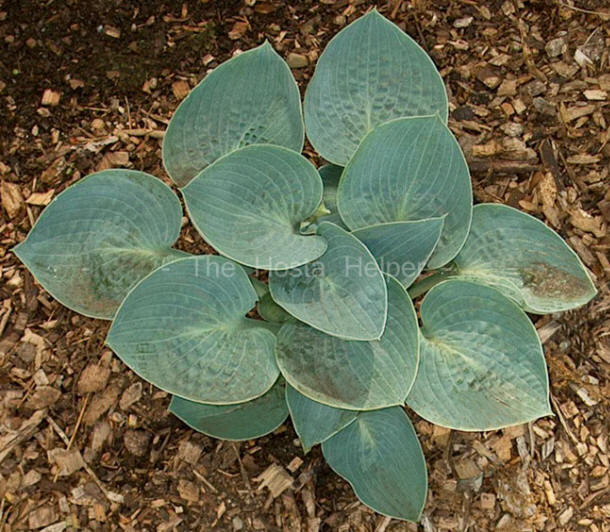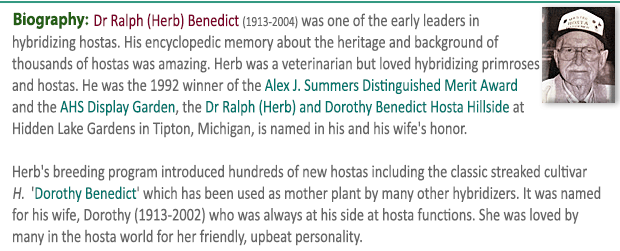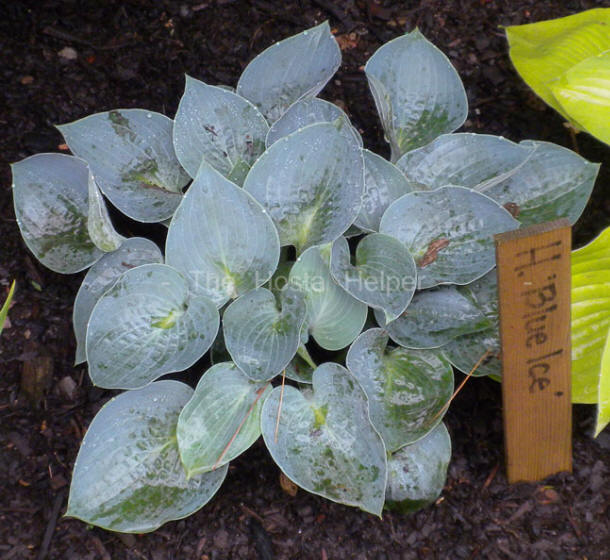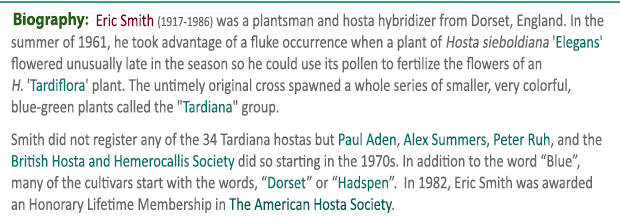|
 Registered in 1987 by
Dr. Ralph (Herb) Benedict of Michigan as a hybrid of H. 'Dorset Blue' × H. 'Blue Moon'. It forms a
small size (8 inches high) mound of deep blue foliage that is heavily
corrugated, cupped and has thick substance. Very pale lavender flowers
bloom
in August. Registered in 1987 by
Dr. Ralph (Herb) Benedict of Michigan as a hybrid of H. 'Dorset Blue' × H. 'Blue Moon'. It forms a
small size (8 inches high) mound of deep blue foliage that is heavily
corrugated, cupped and has thick substance. Very pale lavender flowers
bloom
in August.
The Hostapedia by Mark Zilis (2009), says that this plant falls into a category of
"cultivars that exhibit many
Tardiana traits but are
not a part of Eric Smith's original group."
According to
The Hostapedia by Mark Zilis (2009), "It stands as the first thick-substanced,
blue-leaved hosta in the small size category of any note. Unfortunately, it has an extremely slow growth
rate, taking many years (ten or more) to reach my listed sizes."
 The New Encyclopedia of Hostas by
Diana
Grenfell (2009) states: "Very slow to increase so worth exposing to morning
sun as a young plant to boost its vigor even though it will temporarily lose its
superb leaf color...Good in containers." The New Encyclopedia of Hostas by
Diana
Grenfell (2009) states: "Very slow to increase so worth exposing to morning
sun as a young plant to boost its vigor even though it will temporarily lose its
superb leaf color...Good in containers."
The Book of Little Hostas by Kathy and Michael Shadrack
(2010) says: "The exceptional blue leaf color can be maintained
only by growing this plant out of direct sunlight. The growth
rate makes it ideal for the trough and tray."

The
Hosta Journal (1993 Vol. 24 No. 2) contained an article
by Dr Bob
Olson regarding a visit he and others made to the garden of
Dr Ralph (Herb) Benedict. "We spent the afternoon looking at the end result
of his marvelous hybridization scheme. Dr. Benedict would recite the perfect
logic by which such crosses were conceived and executed.
Tardianas to the F-6 generation were
created by crossing the most fertile of one hundred 'Dorset
Blue's with their most fertile offspring. He ended up creating more new
Tardianas than
Eric Smith
had done. (Smith was thwarted at the F-3 generation when he ran into relatively
sterile plants.) The blues Dr. Benedict chose to name are all rather small and
very blue indeed. In order of decreasing size: 'Blue
Jay', 'Blue Ice', 'Blue
Chip', and the smallest of the lot 'Blue
Urchin'...Somehow in his crosses he came up with a pure Tardiana hybrid
which is streaked and splashed - and give variegated seedlings (often fifty
percent or more)...he produced a 'Dorothy
Benedict'-like-Tardiana, 'Dorset Clown'.
The possibilities of this plant ignited our imaginations: can you envision a
whole series of variegated Tardiana offspring?"









|



